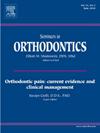Novel method for maxillary protraction following the purely bone-borne mini-screw assisted maxillary skeletal expansion
IF 2.2
4区 医学
Q2 DENTISTRY, ORAL SURGERY & MEDICINE
引用次数: 0
Abstract
The integration of digital technology has revolutionized orthodontic treatment by streamlining traditional processes and enhancing treatment precision and efficiency. Bone Anchored Maxillary Protraction (BAMP) aims to correct the maxillomandibular deficiency for skeletal Class III patients in the middle or late stages of growth. The combination of mini-screw-assisted maxillary skeletal expansion (MARPE) with BAMP is the efficient solution for skeletal transverse and sagittal deficiencies, which aims to maximize skeletal effects while minimizing dental effects. This article presents a novel digital workflow for orthodontic treatment, focusing on mini-screw-assisted maxillary skeletal protraction following transverse expansion. The digital clinic workflow encompasses data acquisition, virtual design and planning, and 3D printing, which minimized the hands-on time of the dental laboratory as much as possible to improve efficiency. Additionally, the article provides a detailed description of the digital methodology for creating custom auxiliaries for maxillary protraction, including types and protocols of 3D printing auxiliaries. A case review demonstrates the application of the digital workflow in treating skeletal Class III malocclusion. Radiological analysis reveals significant improvements in skeletal relationships, with successful maxillary expansion and protraction using the digital method. Digital-assisted orthodontics processes described in this article enhanced the usage of MARPE and BAMP treatment, aiming to enhance efficiency, accuracy, and patient comfort. The integration of digital technologies into orthodontic practice promotes the patient care, streamlines processes, improves accuracy, and enhances communication between practitioners and patients.
单纯骨载微型螺钉辅助上颌骨扩张后上颌前伸的新方法
数字技术的集成通过简化传统流程和提高治疗精度和效率,彻底改变了正畸治疗。骨锚定上颌牵引(BAMP)是针对生长中后期骨骼III类患者的上颌下颌骨缺损进行矫治。微型螺钉辅助上颌骨扩张术(MARPE)与BAMP的结合是解决骨骼横向和矢状面缺陷的有效方法,旨在最大限度地提高骨骼效果,同时减少牙齿影响。本文介绍了一种新型的正畸治疗数字工作流程,重点是在横向扩张后的微型螺钉辅助上颌骨牵伸。数字诊所工作流程包括数据采集、虚拟设计和规划以及3D打印,这将尽可能减少牙科实验室的动手时间,从而提高效率。此外,本文还详细描述了用于创建上颌牵引的自定义辅助设备的数字方法,包括3D打印辅助设备的类型和协议。一个案例回顾证明了数字工作流程在治疗骨骼III类错颌畸形中的应用。放射学分析显示骨骼关系的显著改善,使用数字方法成功地扩展和拉伸上颌。本文中描述的数字辅助正畸过程增强了MARPE和BAMP治疗的使用,旨在提高效率、准确性和患者舒适度。将数字技术整合到正畸实践中,促进了患者护理,简化了流程,提高了准确性,并加强了医生和患者之间的沟通。
本文章由计算机程序翻译,如有差异,请以英文原文为准。
求助全文
约1分钟内获得全文
求助全文
来源期刊

Seminars in Orthodontics
DENTISTRY, ORAL SURGERY & MEDICINE-
CiteScore
2.20
自引率
4.80%
发文量
28
审稿时长
10 days
期刊介绍:
Each issue provides up-to-date, state-of-the-art information on a single topic in orthodontics. Readers are kept abreast of the latest innovations, research findings, clinical applications and clinical methods. Collection of the issues will provide invaluable reference material for present and future review.
 求助内容:
求助内容: 应助结果提醒方式:
应助结果提醒方式:


